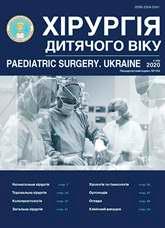Halo-gravity traction in the treatment of complex (>100°) scoliotic deformities of the spine in children: a review of clinical cases
DOI:
https://doi.org/10.15574/PS.2020.69.67Keywords:
spinal deformity, halo-gravity traction, surgical treatmentAbstract
Relevance. The definition of «complex spinal deformity» remains rather vague, but in most publications mark it as a deformation, which on average exceeds 100 degrees. Modern surgical practice of one-stage correction of complex spinal deformities includes performing osteotomies of the spine, which significantly improves the possibility of deformity correction, but also increases the risk of neurological complications and the volume of intraoperative blood loss.
The aim. To improve the results of surgical treatment of patients with complex spinal deformities through the preliminary use of halogravitational traction and to establish an effective and safe algorithm for the treatment of complex spinal deformities in children.
Materials and methods. During the period from 2008 to 2018, the Orthopedic and Traumatology Department of the National Children’s Specialized Hospital «OKHMATDYT» treated 48 children with complex spinal deformities (>100°) using halo-gravity traction. Of these, 32 are boys and 16 are girls. The average age of the patients was 12.9 years. The average Risser score was 4.2 (P>0.01). 27.1% of patients had type 1 deformity according to Lenke, type 2 – 54.1%, type 3 – 8.3%, type 4 – 6.4%, type 5 – 4.1%.
Results and discussion. Using of halo- gravity traction for the preoperative reduction of spinal deformity and prevention of neurological disorders, the average duration of spinal traction application was 46 (P>0.01) days. A weight of 40–50% of the patient’s body weight was used. After the stage of halo-gravity traction, the spine was stabilized with a polysigmentary construction.
Conclusion. Halo-gravity traction as a first stage of severe scoliotic spinal deformations treatment allows to increase the mobility of the vertebral column and to adjust spinal cord step by step for the next correction treatment.
The research was carried out in accordance with the principles of the Helsinki Declaration. The study protocol was approved by the Local Ethics Committee of participating institution.
References
Ashley R1. Garabekyan T, Hosseinzadeh P, Iwinski HJ, Muchow RD, Talwalkar VR, Walker J, Milbrandt TA. (2014). The results of preoperative halo-gravity traction in children with severe spinal deformity. J Pediatr Orthop. B 23: 1-5. https://doi.org/10.1097/BPB.0b013e32836486b6; PMid:23942045
Hui H, Luo ZJ, Yan M, Ye ZX, Tao HR, Wang HQ. (2013). Nonfusion and growing instrumentation in the correction of congenital spinal deformity associated with split spinal cord malformation: an early follow-up outcome. Eur Spine. J 22: 1317-1325. https://doi.org/10.1007/s00586-013-2757-x; PMid:23558579 PMCid:PMC3676561
Li X, Zeng L, Li X, Chen X, Ke C. (2017). Preoperative halogravity traction for severe thoracic kyphoscoliosis patients from Tibet: radiographic correction, pulmonary function improvement, nursing, and complications. Med Sci Monit. 4021-4027. https://doi.org/10.12659/MSM.905358; PMid:28822231 PMCid:PMC5572782
Park DK, Braaksma B, Hammerberg KW, Sturm P. (2013). The efficacy of preoperative halo-gravity traction in pediatric spinal deformity the effect of traction duration. J Spinal Disord Technol. 26: 146-154. https://doi.org/10.1097/BSD.0b013e318237828c; PMid:23750343
Takeshita K, Lenke LG, Bridwell KH, Kim YJ, Sides B, Hensley M. (2006). Analysis of patients with nonambulatory neuromuscular sco-liosis surgically treated to the pelvis with intraoperative halo- femoral traction. Spine. 31: 2381-2385. https://doi.org/10.1097/01.brs.0000238964.73390.b6; PMid:16985468
Yang C, Wang H, Zheng Z, Zhang Z, Wang J, Liu H et al. (2017). Halogravity traction in the treatment of severe spinal deformity: a systematic review and meta-analysis. Eur Spine J. 26(7): 1810-1816. https://doi.org/10.1007/s00586-016-4848-y; PMid:27858237
Yang C, Zheng Z, Liu H, Wang J, Kim YJ, Cho S. (2016). Posterior vertebral column resection in spinal deformity: a systematic review. Eur Spine J. 25(8): 2368-2375. https://doi.org/10.1007/s00586-015-3767-7; PMid:25599850
Zhang ZX, Hui H, Liu TJ, Zhang ZP, Hao DJ. (2016). Two-staged correction of severe congenital scoliosis associated with intraspinal abnormalities. Clin Spine Surg. 29(8): E401-405. https://doi.org/10.1097/BSD.0000000000000175; PMid:25310398
Downloads
Published
Issue
Section
License
The policy of the Journal “PAEDIATRIC SURGERY. UKRAINE” is compatible with the vast majority of funders' of open access and self-archiving policies. The journal provides immediate open access route being convinced that everyone – not only scientists - can benefit from research results, and publishes articles exclusively under open access distribution, with a Creative Commons Attribution-Noncommercial 4.0 international license(СС BY-NC).
Authors transfer the copyright to the Journal “PAEDIATRIC SURGERY.UKRAINE” when the manuscript is accepted for publication. Authors declare that this manuscript has not been published nor is under simultaneous consideration for publication elsewhere. After publication, the articles become freely available on-line to the public.
Readers have the right to use, distribute, and reproduce articles in any medium, provided the articles and the journal are properly cited.
The use of published materials for commercial purposes is strongly prohibited.

